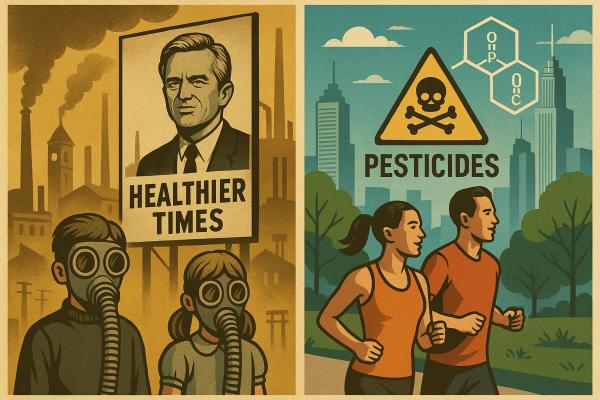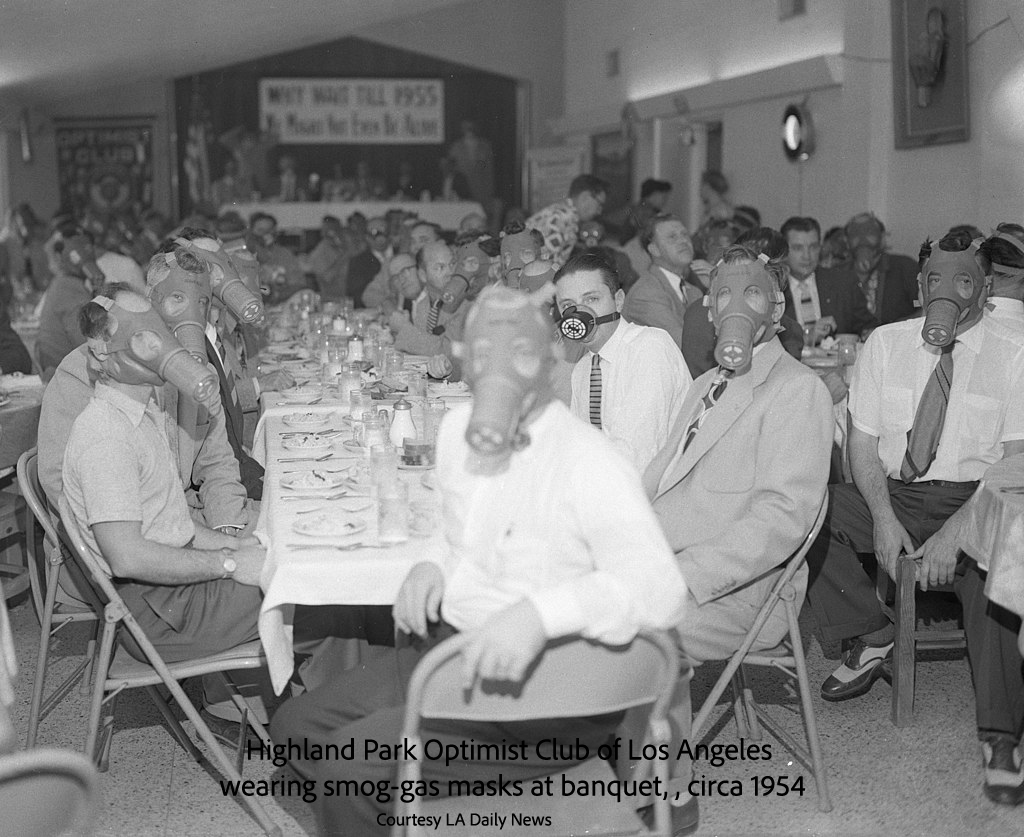
Beyond formatting concerns, the MAHA report blames synthetic chemicals for our obesity, eczema, and chronic disease-ridden children. Conjuring environmental chemical exposure conveniently seeds a new correlation, laying an artificial basis for causal claims between these chemicals and certain childhood diseases. To add luster to this warped view, HHS Secretary Robert F. Kennedy Jr. argues that Americans were healthier in the '50s and '60s, presumably an era before the widespread use of synthetic environmental chemicals and pesticides.
“RFK Jr. says Americans were healthier when his uncle was president. Is he right?”
As a former environmental advocate, Kennedy should be well-versed in America’s environmental exposure history. Let’s assess how valid his assessments are and how wise his presumed solutions may be.
“American children’s exposure to environmental chemicals. The cumulative load of thousands of synthetic chemicals that our children are exposed to through the food they eat, the water they drink, and the air they breathe may pose risks to their long-term health, including neurodevelopmental and endocrine effects. “
– MAHA Report
The Good Ole Days
I remember the 50s and '60s as days when we dived under our desks during air raid drills and learned how to stock the underground bomb shelter built in the back yard -- in case of nuclear war. So, maybe we were physically healthier, but we were also freaked out of our minds. It is true that during my teens, most kids were thinner. But then again, just about everyone smoked (cigarettes, not weed), perhaps to distract themselves from the fragmenting environment.
A “1968 UNESCO conference concluded that man had only about 20 more years before the planet start[s]… to become uninhabitable because of air pollution alone” - Paul Ehrlich (1970)
The Silent Spring Years
During college, when the smoking now included pot and LSD parties proliferated on the quad, I recall biology professor ornithologist William Keeton lambasting DDT – contributing to its later and catastrophic ban. Environmental and ecological activists like Rachel Carson, author of Silent Spring, and Paul Ehrlich, author of Population Resources Environment, sounded in.
According to Ehrlich, in the late 1960s, air pollution added more than 140 million tons of pollutants per year, almost three-quarters of a ton annually for every man, woman, and child in the US. In no small measure, these emanations caused smog.
Remember Smog?
 Smog is a visible cloud of air pollution characterized by a hazy, smoky, and often yellow-brownish appearance. It generally presented when “favorable” climate conditions existed in tandem with high levels of particulates, notably rendering Los Angeles and its environs harmful for sensitive populations (including children) – during the 1960s. Ehrlich writes that physicians advised some 10,000 respiratory patients to leave the area.
Smog is a visible cloud of air pollution characterized by a hazy, smoky, and often yellow-brownish appearance. It generally presented when “favorable” climate conditions existed in tandem with high levels of particulates, notably rendering Los Angeles and its environs harmful for sensitive populations (including children) – during the 1960s. Ehrlich writes that physicians advised some 10,000 respiratory patients to leave the area.
1970 – The Year Earth Day Was Born
With a backdrop of the pesticide exposures haunting the Viet Nam war (like Agent Orange, first used in 1962), by 1970, environmental breakdown in America was too obvious to ignore, spawning the birth of the Environmental Protection Agency (EPA), enactment of OSHA, creation of the Toxic Substances Registry, and implementation of the National Environmental Policy Act (NEPA).
For the first time, many dangerous and concerning chemicals were monitored, and exposures were restricted or banned. Prior to the 1970s, a half-century before the proliferation of childhood type 2 diabetes and obesity, exposures to all pesticides, pollutants, and workplace hazards were hundreds or thousands of times greater than they are today. These legal initiatives generated multi-million-dollar fines, penalties, and judgments that deterred further pollution. We don’t see much smog anymore –mainly because of the profusion of an alphabet soup of regulations that emerged when I was in law school, including:
- CERCLA - The Comprehensive Environmental Response, Compensation, and Liability Act, called the “Superfund Law,” was enacted in 1980, addressing environmental releases of hazardous substances and holding everyone even remotely associated with the pollution liable. This, for the first time, incorporates retroactive liability for pollution that occurred even before the law was enacted. Upgraded as the Superfund Reauthorization Act in 1986, the law was further tightened.
- RCRA - The Resource Conservation and Recovery Act, enacted in 1976, governs the "cradle-to-grave" disposal, transportation, treatment, storage, and disposal of solid and hazardous waste.
- FIFRA –The predecessor to the Federal Insecticide, Fungicide, and Rodenticide Act, which regulates the production, distribution, sale, and use of pesticides in the United States, was first enacted as the Federal Insecticide Act in 1910, but its “muscle” was tested decades later when insecticide proliferation increased, and FIFRA was enacted.
The MAHA Report tells us that today:
“Over 40,000 chemicals are registered for use in the US. Pesticides, microplastics, and dioxins are commonly found in the blood and urine of American children and pregnant women—some at alarming levels. … Research suggests that for some chemicals, this cumulative load of exposures may be driving higher rates of chronic childhood diseases.”
This is nothing new.
“By [the RFK Jr Golden Year of ] 1950…., pesticide production had jumped to 300 million pounds annually from 100 million pounds annually in 1945.”
Pesticides proliferated during the last century until the stricter regulations of the 1970s and 1980s crippled use and featured such noxious examples as creosote and pentachlorophenol, a persistent carcinogenic organic pollutant [1]. The increased use reflected the country’s growing industrialization, in this instance, the transcontinental railroad expansion, which required insecticides to protect wooden ties. The poisonous footprints of these chemicals persisted for decades as tie-treating plants became hazardous waste sites, with cleanup efforts ongoing until approximately 2000.
By 1987, Americans used over one billion pounds of pesticides for agricultural, industrial, and household purposes. And by 1989, “the EPA … registered approximately fifty thousand pesticide products derived from six hundred active ingredients. “ [emphasis added]. The US Army used chemical weapons during the 1960s, employing methods like sea disposal, open-pit burning, and land burial for destruction, facilitating noxious exposure- all during the halcyon 60s.
A is for Alar
When I entered legal practice, required reading included the controversy surrounding Alar, a plant growth regulator sprayed on apple trees to prevent the fruit from falling before it is ripe and “used to enhance the quality and appearance of apples.” Alar (trade name for daminozide) came to prominence in the late 1980s, generating country-wide outrage when its toxicity to children was publicized
“Our nation's children are being harmed by the very fruits and vegetables we tell them will make them grow up healthy and strong." – National Resource Defense Council (NRDC)
This is not from the MAHA report but rather from a twenty-five-year-old NRDC “peer-reviewed study” called "Intolerable Risk," revealing that the diets of America's preschoolers contained “dangerous levels of pesticide residues and exposed our nation's failure to adequately protect children from agrichemical risks.”
In 1993, the National Academy of Sciences issued a report titled “Pesticides in the Diets of Infants and Small Children,“ confirming that “Children are more vulnerable to dietary pesticide exposures.” By 1996, the chemical had been banned, and the country enacted the Food Quality Protection Act, which required stricter safety standards, especially for infants and children.
Despite the anti-Alar indictment, since 1990, no reliable studies have shown a link between Alar (or its byproduct UMDH) and cancer, with experts and agencies like the FDA and the International Agency for Research on Cancer (IARC) affirming its safety (though it remains banned on US food crops and classified as a carcinogen),
The Pollution Song is 75 years old
The long history, severity, and ubiquitous nature of environmental exposures is reflected in Tom Lehrer’s iconic song Pollution, which was written in the 1960 Camelot of Secretary Kennedy Jr’s uncle.
It may well be that to the Brahmin class, the RFK Jr.’s, their relations and acquaintances, the 50s and 60a were idyllic, pristine, pure, and perfect. However, to many American children, it wasn‘t. Fathers suffered pulmonary fibrosis from coal, cotton, asbestos, and glass dust ( “nice” natural substances), teens were exposed to the pesticides coloring their Viet Nam engagement, and children succumbed to malaria as DDT (the most effective anti-malarial agent we have) was banned due to environmental overzealousness. Maybe rural air in Hyannis was pristine; city air wasn’t.
This is old news. We may be exposed to different and perhaps dangerous chemicals today, but at least they are at far lower exposures than at any time in our history. We also have a regulatory framework in place to address this issue. We might even have the scientific infrastructure and researchers to determine if these chemicals are proportionately risky - had their ranks not been denuded by the MAHA Report’s ultimate author.
“Making chemicals the culprits again” to address new epidemics only generates an artificial correlation between some “hallucinated” increased chemical exposures and new disease parameters. The model creates scapegoats and may well divert attention from real concerns and the aftermath of untoward initiatives.
[1] causally related to pancreatitis, jaundice, acute renal failure, intravascular hemolysis, and pulmonary edema



